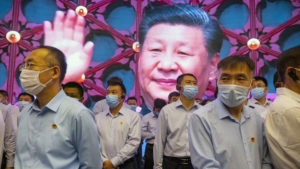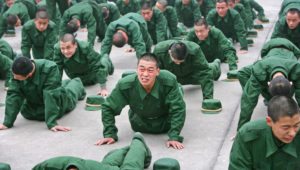At the Chinese Communist Party’s 20th Congress this week, Xi Jinping will be nominated for a precedent-defying third term of office. But his grasp on power has not gone unchallenged. Days before the Congress began, a rare protest took place on Sitong bridge in Beijing, calling for the removal of “dictator and traitor Xi Jinping”. “We want to be citizens, not slaves,” read one banner.
It is an inauspicious time for the CCP. In his opening speech, Xi warned of a period of fragility ahead. The government is having to contend with a faltering economy, hindered by a bust in the real-estate market and the ongoing ramifications of Zero-Covid policies. In a further blow to investor confidence, China’s National Bureau of Statistics has delayed the release of its economic growth and other figures until after Congress. All this is taking place against a troubled international backdrop characterised by China’s support for Russia’s protracted war in Ukraine, and rising hostility with the United States.
So far, at least in public, the Congress has been more about pomp and politics than policy. China-watchers will be looking for clues as to which new political leaders will join Politburo and the Politburo Standing Committee on Saturday. But they will also be listening out for any reference to two important policy initiatives.
The first revolves around radical new US Commerce Department regulations, brought into effect last Friday, which are designed to restrict China’s access to a broad array of advanced semiconductor equipment, whether US-made, or using US technology. The restrictions will also apply to Americans working in the Chinese semiconductor manufacturing industry, making them subject to US law.
The move sends a clear message: that the US government is no longer prepared to accommodate China’s semiconductor technology acquisition practices. The regulations seem to be designed to hinder, if not decapitate, China’s advanced chip industry, and in doing so confirm the CCP’s narrative that the US is out to contain China and interfere with its right to take its proper place in the world system. In his speech, Xi spoke of the need to protect China from “external attempts to suppress and contain” it. We should expect Beijing to retaliate after the Congress, hitting back economically against American firms and business interests.
The second issue is Common Prosperity. Resurrected in 2021, Common Prosperity is a political slogan and a theme that Xi has described as an essential part of socialism. It is designed to capture the government’s intention to improve the quality of life for China’s middle class and its aspirant members, including owners of small-businesses, migrant workers, and farmers. Its alleged goal is to lower those income and regional inequalities that have blighted China’s economic and social progress, and which might, if unaddressed, trigger social stress and unrest.
Common Prosperity, however, remains a vague concept. Xi has explained that it is not about egalitarianism, or a Western-style welfare state. In his opening address to the Congress, Xi spoke about the need to ensure income distribution and wealth accumulation were “well-regulated”. However, there is nothing on China’s policy agenda that would suggest more generous benefit arrangements for pensions, unemployment, medical needs, housing, and education.
This does not accord with the liberal capitalist view that inequality can be narrowed via redistribution — but the CCP thinks about these things differently. It believes that if you can grow the economy enough and regulate private capital properly, the benefits will flow to all citizens. Hence its crackdown on private firms and entrepreneurs in the technology, financial and data platform sectors, the gig economy, and private tutoring. Healthcare and housing providers have also been in the policy crosshairs. The CCP has insisted there needs to be a more “orderly expansion of capital”, presumed to mean more scrutiny over what firms spend money on. It has also brought in a series of measures designed to make private firms align their commercial interests with CCP goals and oblige them to make “donations” to party causes.
There is no question that China has a major problem with income inequality, which is not only high now, but has remained persistently high over time. Its Gini coefficient — a measure of income inequality where 0 equates to perfect equality and 1 to total inequality — was about 0.54-0.55 in 2019, according to the China Family Panel Studies survey. This was far higher than in most developed economies. The top 20% of income earners receive about 46% of income, virtually unchanged over the last decade or so, while the bottom 40% get slightly more than 13%. Until now, Chinese citizens have been willing to accept that the CCP would continue to enhance living standards and prosperity for future generations, but if citizens begin to doubt this, the government will have to watch out.
Income inequality is high in China, partly because of familiar problems of richer households getting most of the benefits of economic growth, but also because wages and salaries — and, therefore, consumption — account for a low proportion of GDP, and the state for a relatively high 40% of GDP. Compared with developed nations, Chinese households are much worse off because social welfare payments and transfers to households account for about 8-9% of GDP, compared with 15-20% in the US and the EU.
If Common Prosperity were a solution to inequality rather than an empty slogan, China would have to set about reforming its income distribution and tax and social security systems, as well as redistributing income and wealth from the public to the private sector. Moreover, it would have to address important structural problems, including the status of the roughly 200 million migrant workers — around 71% of the total — who do not have urban registration (or hukou), and therefore do not get free access to public education, housing, or welfare in the cities where they work. It would also seek to improve the lot of a rapidly ageing population as the cohort of citizens aged over-60 rises from 250 million, or 18% of the population, to well over 400 million, or almost 35%, by 2045. This could exacerbate inequality if nothing is done about it.
One of the most pressing tasks is to increase educational attainment and employment opportunities for China’s citizens, especially those who live in rural areas. Whereas in the past, China needed workers who were simply numerate, literate, and disciplined, it now needs workers who are educated to much higher levels and who can compete in an increasingly technological and digital work environment. But the trend is going the wrong way: in 2020, around 60% of Chinese workers in urban areas were employed in the informal sector where low skills and poor pay prevail, up from 40% about 20 years ago.
Building a modern workforce is no easy task. By 2020, only about 37% of Chinese workers had high school educational qualifications or better, compared with 78% in developed nations, and only about 17% had tertiary sector qualifications, compared with 35% in wealthy countries. Nowadays, younger Chinese are getting better schooling than their parents, but it will take a generation or more to improve overall educational attainment assuming that requisite improvements are made in schools and universities.
Meanwhile, Chinese households are facing much greater uncertainty. Xi’s tech and regulatory crackdown, and especially the bust in real estate, has reduced the asset wealth of the middle class, while the faltering economy and rising unemployment have made everyone worse off. Even the tech industry is laying people off, and now with the Chinese semiconductor industry under the cosh, further job losses are likely. Zero-Covid policies, which look likely to persist at least until next spring, if not longer, have not helped the cause of fighting inequality because so many low-pay and low-skill workers have been affected in the retail, ride-hailing, transportation, hospitality, and catering sectors.
The CCP’s legitimacy has rested on its ability to assure citizens that economic prosperity would only improve, and yet the prospects in this decade and beyond suggest strongly that this might not happen as expected. China’s growth rate is shrinking from about 5-6% in the 2010s to perhaps no more than 2.5-3% in the 2020s. Common Prosperity may be the CCP’s last chance to address the heart of the problem, but as far as we can tell, this is based more on hope than evidence. The possibility emerges, then, of either rising social stress or unrest — or of political instability in the upper echelons of the CCP.
Notwithstanding the rhetoric and fanfare of success that will doubtless ring from the Great Hall of the People this week, China faces testing and, in some ways, troubling times ahead. Its economy is Xi Jinping’s Achilles’ heel.
Disclaimer
Some of the posts we share are controversial and we do not necessarily agree with them in the whole extend. Sometimes we agree with the content or part of it but we do not agree with the narration or language. Nevertheless we find them somehow interesting, valuable and/or informative or we share them, because we strongly believe in freedom of speech, free press and journalism. We strongly encourage you to have a critical approach to all the content, do your own research and analysis to build your own opinion.
We would be glad to have your feedback.
Source: UnHerd Read the original article here: https://unherd.com/




